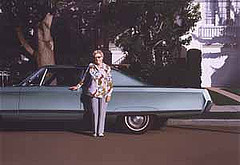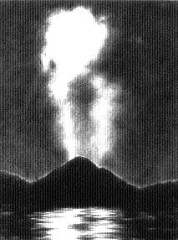
Alameda Chrysler by Robert Bechtle
I’ve got about a year of Art in Americas floating around the house, waiting for me to pick them up and read them. I got so far behind that I haven’t renewed and will not until I catch up with what I have.
Some time over the holiday weekend, I picked one of them up–one still wrapped in plastic–and discovered a terrific article on Robert Bechtle, that trickster painter of not-quite photographic realities, and an article about April Gornick, another trickster painter not to be trusted. I love both of these artists for just about the same reason, yet they are a study in contrasting methodology.
In fact, had I not read these two articles in the Nov. 2005 issue of AiA, I don’t know that the obituary quote from this morning’s newspaper (see my previous post) would have been as meaningful to me. But AiA had already set me mulling about “realism” in both bodies of work.
Bechtle’s deadpan paintings of ordinary suburban life-with-cars, with their photo-realist underpinnings, are not mere recordings of photographic reality, although they are based on photographs and invoke photographs, with that flat camera-eye viewpoint.
But the compositions are beautiful and considered, the background details pared down to sharp-edged basics. They are paintings that have ominous shadows, brutal California sunlight or dark night light, and no sense of Beach Boys fun fun fun. They consider houses and cars as flattened shapes for reflecting (or not reflecting) light off their surfaces. The implacable sunlight and suggested heat rising off the pavement are oppressive. The whole label Photo-Realism seems irrelevant except to denote Bechtle’s process, a way of tripping the viewer into belief that the vision is reality. But it’s only reality in so far as it’s the artist’s reality.

Cloud Plume, by April Gornick
April Gornick comes from the other direction. She is shameless in her hallucinatory version of what a landscape is. She boldly declares it is not reality she is painting, but rather the landscape of her mind and emotions.
Both of these artists, working through conventions of realism, undercut it. They’ve been painting for a long time, but clearly questions about what is real and what is not have been around for a long time. This subject matter–the slippery quality of reality and truth–is an especially fine thought for our times, where even our language uses “virtual reality” to mean no reality at all.








